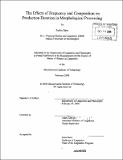| dc.contributor.advisor | Adam Albright. | en_US |
| dc.contributor.author | Tapio, Sophia | en_US |
| dc.contributor.other | Massachusetts Institute of Technology. Dept. of Linguistics and Philosophy. | en_US |
| dc.date.accessioned | 2009-06-30T16:40:17Z | |
| dc.date.available | 2009-06-30T16:40:17Z | |
| dc.date.copyright | 2008 | en_US |
| dc.date.issued | 2008 | en_US |
| dc.identifier.uri | http://hdl.handle.net/1721.1/45931 | |
| dc.description | Thesis (S.M.)--Massachusetts Institute of Technology, Dept. of Linguistics and Philosophy, 2008. | en_US |
| dc.description | Includes bibliographical references (p. 34-35). | en_US |
| dc.description.statementofresponsibility | by Sophia Tapio. | en_US |
| dc.format.extent | 45 p. | en_US |
| dc.language.iso | eng | en_US |
| dc.publisher | Massachusetts Institute of Technology | en_US |
| dc.rights | M.I.T. theses are protected by
copyright. They may be viewed from this source for any purpose, but
reproduction or distribution in any format is prohibited without written
permission. See provided URL for inquiries about permission. | en_US |
| dc.rights.uri | http://dspace.mit.edu/handle/1721.1/7582 | en_US |
| dc.subject | Linguistics and Philosophy. | en_US |
| dc.title | The effects of frequency and composition on production duration on morphological processing | en_US |
| dc.type | Thesis | en_US |
| dc.description.degree | S.M. | en_US |
| dc.contributor.department | Massachusetts Institute of Technology. Department of Linguistics and Philosophy | |
| dc.identifier.oclc | 320841127 | en_US |
| dc.audience.educationlevel | Introduction: Parts of words combine just like parts of sentences. This property of Distributed Morphology (Halle and Marantz 1993) raises the empirical question: if duration is manipulated at prosodic boundaries in sentences, is it likewise manipulated within words? There is scant literature addressing the question whether there are phonetic correlates to boundaries in morphological processing. In the domain of sentence production, pauses before intonational phrase (IP) boundaries have been shown to vary in duration depending on properties of subsequent material (Ferreira 1991, Krivokapic 2007). Segments lengthen before IP boundaries whether or not pauses occur (Klatt 1975). Under the view that there is no difference between combining morphemes and composing larger phrases, it is expected for segments near morpheme boundaries to vary in the same way segments near larger phrase boundaries vary. This is the line taken in Marvin (2002) where it is argued that stress can diagnose sisterhood domains word-internally. A relationship between base form frequency and surface form frequency has been argued to influence the perception of word complexity (Hay 2001, 2003). Under the assumption that segments preceding boundaries are longer than those that do not precede boundaries in phonetic implementation, and given that lexical access is involved in the retrieval of a phonological representation during production, it is an empirical question whether a property of lexical access affects production delay at a morpheme juncture. In experiment 1, it is tested whether there is an effect of whole-form versus decomposed lexical access in production. The prediction is that segments next to boundaries in decompositionally-accessed words are longer than corresponding segments in whole-accessed words. An effect of boundary strength is predicted under an assumption that planning takes longer for more syntactically complex material. Experiment 2 tests the prediction that a boundary between adjacent morphemes that are not sisters is longer than a boundary between morphemes that are sisters. An effect is expected if morphemes combine like words as units of processing. Positive results in either experiment 1 or 2 would introduce segment duration as a tool for investigating morphological processing. Various factors contributing to the ease of decomposition have received attention in the domain of perception (Bertram, Schreuder, and Baayen 2000; Hay 2003). The experiments presented in this work explore morphological production. In section 2, it is investigated whether segmental duration is affected by a preceding boundary posited by lexical access. Section 3 tests predictions about relative boundary strength at different levels of word-internal prosodic structure. Section 4 concludes. | en_US |

